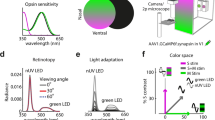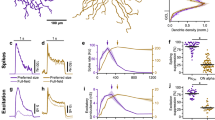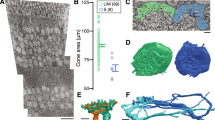Abstract
Vertebrate vision relies on two types of photoreceptors, rods and cones, which signal increments in light intensity with graded hyperpolarizations. Rods operate in the lower range of light intensities while cones operate at brighter intensities. The receptive fields of both photoreceptors exhibit antagonistic center-surround organization. Here we show that at bright light levels, mouse rods act as relay cells for cone-driven horizontal cell–mediated surround inhibition. In response to large, bright stimuli that activate their surrounds, rods depolarize. Rod depolarization increases with stimulus size, and its action spectrum matches that of cones. Rod responses at high light levels are abolished in mice with nonfunctional cones and when horizontal cells are reversibly inactivated. Rod depolarization is conveyed to the inner retina via postsynaptic circuit elements, namely the rod bipolar cells. Our results show that the retinal circuitry repurposes rods, when they are not directly sensing light, to relay cone-driven surround inhibition.
This is a preview of subscription content, access via your institution
Access options
Subscribe to this journal
Receive 12 print issues and online access
$209.00 per year
only $17.42 per issue
Buy this article
- Purchase on Springer Link
- Instant access to full article PDF
Prices may be subject to local taxes which are calculated during checkout








Similar content being viewed by others
References
Yau, K.-W. & Hardie, R.C. Phototransduction motifs and variations. Cell 139, 246–264 (2009).
Wässle, H. Parallel processing in the mammalian retina. Nat. Rev. Neurosci. 5, 747–757 (2004).
Peichl, L. & González-Soriano, J. Morphological types of horizontal cell in rodent retinae: a comparison of rat, mouse, gerbil, and guinea pig. Vis. Neurosci. 11, 501–517 (1994).
Kolb, H. The connections between horizontal cells and photoreceptors in the retina of the cat: electron microscopy of Golgi preparations. J. Comp. Neurol. 155, 1–14 (1974).
Kolb, H. Organization of the outer plexiform layer of the primate retina: electron microscopy of Golgi-impregnated cells. Phil. Trans. R. Soc. Lond. B 258, 261–283 (1970).
Babai, N. & Thoreson, W.B. Horizontal cell feedback regulates calcium currents and intracellular calcium levels in rod photoreceptors of salamander and mouse retina. J. Physiol. (Lond.) 587, 2353–2364 (2009).
Baylor, D.A., Fuortes, M.G. & O'Bryan, P.M. Receptive fields of cones in the retina of the turtle. J. Physiol. (Lond.) 214, 265–294 (1971).
Davenport, C.M., Detwiler, P.B. & Dacey, D.M. Effects of pH buffering on horizontal and ganglion cell light responses in primate retina: evidence for the proton hypothesis of surround formation. J. Neurosci. 28, 456–464 (2008).
Nelson, R., von Litzow, A., Kolb, H. & Gouras, P. Horizontal cells in cat retina with independent dendritic systems. Science 189, 137–139 (1975).
Pan, F. & Massey, S.C. Rod and cone input to horizontal cells in the rabbit retina. J. Comp. Neurol. 500, 815–831 (2007).
Thoreson, W.B., Babai, N. & Bartoletti, T.M. Feedback from horizontal cells to rod photoreceptors in vertebrate retina. J. Neurosci. 28, 5691–5695 (2008).
Trümpler, J. et al. Rod and cone contributions to horizontal cell light responses in the mouse retina. J. Neurosci. 28, 6818–6825 (2008).
Thoreson, W.B. & Mangel, S.C. Lateral interactions in the outer retina. Prog. Retin. Eye Res. 31, 407–441 (2012).
Bloomfield, S.A. & Völgyi, B. The diverse functional roles and regulation of neuronal gap junctions in the retina. Nat. Rev. Neurosci. 10, 495–506 (2009).
Asteriti, S., Gargini, C. & Cangiano, L. Mouse rods signal through gap junctions with cones. Elife 3, e01386 (2014).
Ribelayga, C., Cao, Y. & Mangel, S.C. The circadian clock in the retina controls rod-cone coupling. Neuron 59, 790–801 (2008).
Yau, K.W. Phototransduction mechanism in retinal rods and cones. The Friedenwald Lecture. Invest. Ophthalmol. Vis. Sci. 35, 9–32 (1994).
Tsukamoto, Y., Morigiwa, K., Ueda, M. & Sterling, P. Microcircuits for night vision in mouse retina. J. Neurosci. 21, 8616–8623 (2001).
Li, P.H., Verweij, J., Long, J.H. & Schnapf, J.L. Gap-junctional coupling of mammalian rod photoreceptors and its effect on visual detection. J. Neurosci. 32, 3552–3562 (2012).
Biel, M. et al. Selective loss of cone function in mice lacking the cyclic nucleotide-gated channel CNG3. Proc. Natl. Acad. Sci. USA 96, 7553–7557 (1999).
Chang, B. et al. Cone photoreceptor function loss-3, a novel mouse model of achromatopsia due to a mutation in Gnat2. Invest. Ophthalmol. Vis. Sci. 47, 5017–5021 (2006).
Altimus, C.M. et al. Rod photoreceptors drive circadian photoentrainment across a wide range of light intensities. Nat. Neurosci. 13, 1107–1112 (2010).
Lyubarsky, A.L., Falsini, B., Pennesi, M.E., Valentini, P. & Pugh, E.N. Jr. UV- and midwave-sensitive cone-driven retinal responses of the mouse: a possible phenotype for coexpression of cone photopigments. J. Neurosci. 19, 442–455 (1999).
Siegert, S. et al. Transcriptional code and disease map for adult retinal cell types. Nat. Neurosci. 15, 487–495, S1–S2 (2012).
Berndt, A., Yizhar, O., Gunaydin, L.A., Hegemann, P. & Deisseroth, K. Bi-stable neural state switches. Nat. Neurosci. 12, 229–234 (2009).
Vroman, R., Klaassen, L.J. & Kamermans, M. Ephaptic communication in the vertebrate retina. Front. Hum. Neurosci. 7, 612 (2013).
Vessey, J.P. et al. Proton-mediated feedback inhibition of presynaptic calcium channels at the cone photoreceptor synapse. J. Neurosci. 25, 4108–4117 (2005).
Guo, C., Hirano, A.A., Stella, S.L. Jr., Bitzer, M. & Brecha, N.C. Guinea pig horizontal cells express GABA, the GABA-synthesizing enzyme GAD 65, and the GABA vesicular transporter. J. Comp. Neurol. 518, 1647–1669 (2010).
Hirasawa, H. & Kaneko, A. pH changes in the invaginating synaptic cleft mediate feedback from horizontal cells to cone photoreceptors by modulating Ca2+ channels. J. Gen. Physiol. 122, 657–671 (2003).
Kamermans, M. et al. Hemichannel-mediated inhibition in the outer retina. Science 292, 1178–1180 (2001).
Wang, T.-M., Holzhausen, L.C. & Kramer, R.H. Imaging an optogenetic pH sensor reveals that protons mediate lateral inhibition in the retina. Nat. Neurosci. 17, 262–268 (2014).
Liu, X., Hirano, A.A., Sun, X., Brecha, N.C. & Barnes, S. Calcium channels in rat horizontal cells regulate feedback inhibition of photoreceptors through an unconventional GABA- and pH-sensitive mechanism. J. Physiol. (Lond.) 591, 3309–3324 (2013).
Clark, D.A., Benichou, R., Meister, M. & Azeredo da Silveira, R. Dynamical adaptation in photoreceptors. PLoS Comput. Biol. 9, e1003289 (2013).
Tomomura, M., Rice, D.S., Morgan, J.I. & Yuzaki, M. Purification of Purkinje cells by fluorescence-activated cell sorting from transgenic mice that express green fluorescent protein. Eur. J. Neurosci. 14, 57–63 (2001).
Münch, T.A. et al. Approach sensitivity in the retina processed by a multifunctional neural circuit. Nat. Neurosci. 12, 1308–1316 (2009).
Deans, M.R., Volgyi, B., Goodenough, D.A., Bloomfield, S.A. & Paul, D.L. Connexin36 is essential for transmission of rod-mediated visual signals in the mammalian retina. Neuron 36, 703–712 (2002).
Ke, J.-B. et al. Adaptation to background light enables contrast coding at rod bipolar cell synapses. Neuron 81, 388–401 (2014).
Naarendorp, F. et al. Dark light, rod saturation, and the absolute and incremental sensitivity of mouse cone vision. J. Neurosci. 30, 12495–12507 (2010).
Grimes, W.N., Schwartz, G.W. & Rieke, F. The synaptic and circuit mechanisms underlying a change in spatial encoding in the retina. Neuron 82, 460–473 (2014).
Farrow, K. et al. Ambient illumination toggles a neuronal circuit switch in the retina and visual perception at cone threshold. Neuron 78, 325–338 (2013).
Siegert, S. et al. Genetic address book for retinal cell types. Nat. Neurosci. 12, 1197–1204 (2009).
Grieger, J.C., Choi, V.W. & Samulski, R.J. Production and characterization of adeno-associated viral vectors. Nat. Protoc. 1, 1412–1428 (2006).
Rae, J., Cooper, K., Gates, P. & Watsky, M. Low access resistance perforated patch recordings using amphotericin B. J. Neurosci. Methods 37, 15–26 (1991).
Acknowledgements
We thank C. Cepko, L. Vandenberghe and S. Rompani for help with high-yield AAV production and P. King, S. Oakeley and members of the Roska laboratory for commenting on the manuscript. We acknowledge the following grants: a Human Frontier Science Program fellowship to S.T.; Boehringer Ingelheim Fonds fellowship to A.D.; Gebert-Ruf Foundation, Swiss National Science Foundation, European Research Council, Swiss-Hungarian National Centres of Competence in Research Molecular Systems Engineering, Sinergia and European Union SEEBETTER, TREATRUSH, OPTONEURO and 3X3D Imaging grants to B.R.; and a Sinergia grant and Centre National de la Recherche Scientifique through UMR 8550 to R.A.S.
Author information
Authors and Affiliations
Contributions
T.S. performed all experiments with rods and cones, recorded from horizontal and rod bipolar cells, did injections, designed experiments, built the two-photon microscope and wrote the paper. S.T. recorded from horizontal and rod bipolar cells. A.D. did AAV injections and quantified the horizontal cell AAV infections. J.J. designed and made the AAV vectors and did AAV injections. Z.R. developed the stimulation and recording software. K.F. built the two-photon microscope and recorded from ganglion cells. M.B. provided the Cnga3−/− mouse. G.A. designed experiments. D.A.C. developed and implemented the quantitative model and performed simulations. J.-A.S. suggested the experiments with the spectrally opponent rod pathway. R.A.d.S. developed the quantitative model, designed experiments and wrote the paper. B.R. designed experiments, implemented the model and wrote the paper.
Corresponding author
Ethics declarations
Competing interests
The authors declare no competing financial interests.
Integrated supplementary information
Supplementary Figure 1 Light responses of rod photoreceptors in mouse whole mount retina.
a, First column shows the mean and standard error of rod depolarization evoked by a 800 μm spot at 1090 R*/s intensity. In the second and third column rod depolarization to 800 μm spot are compared in two different experimental conditions. Second column: rod depolarization was recorded immediately after getting electrical access to rods. Third column: rod depolarization was recorded at the end of the experimental series shown in Fig. 1a. Significance was tested by Mann-Whitney U test, p = 0.37. b, Normalized response magnitudes in whole mount rods at five background intensities and different spot sizes. c, Rod depolarization at high background light levels increased with increasing positive contrast. d, Rods responded with hyperpolarization to negative contrast, and the hyperpolarization increased with increasing negative contrast.
Supplementary Figure 2 Rod responses in Gnat2cpfl3 mouse.
a, Rod responses at two different background intensities in Gnat2cpfl3 mice. The stimulus was a spot of 800 μm. b, Quantification, responses were normalized to the maximum hyperpolarization evoked by the 0.26 R*/s stimulus.
Supplementary Figure 3 Channelrhodopsin expression in horizontal cells.
We delivered a bi-stable channelrhodopsin (bi-ChR2) to horizontal cells using conditional adeno-associated viruses. A single subretinal injection led to the labeling of horizontal cells across the entire retina.
Supplementary Figure 4 Sequence of light stimulation in the experiments using reversible inactivation of horizontal cells.
First, the retina was stimulated with a test flash, a white spot of 800 µm in diameter shown for 2s. The test flash was not bright enough to activate bi-ChR2 (Fig. 4j). Second, a switch flash was presented. The switch flash was a blue full-field light step that lasted 50 ms. The switch flash was brighter than the test flash and it activated bi-ChR2 (Fig. 4j). Third, a test flash was presented again 10s after the switch flash. After waiting for 5 min we started a new “test flash-switch flash-test flash” cycle. The cycle was then repeated.
Supplementary Figure 5 The influence of picrotoxin and strychnine on the depolarizing rod response.
The effect of the GABA receptor blocker picrotoxin and the glycine receptor blocker strychnine on the depolarizing rod response evoked by a 800 µm diameter spot at 1090 R*/s intensity.
Supplementary Figure 6 The ‘seesaw‘ model at daylight intensities.
Light stimulus leads to cone and, subsequently, horizontal cell hyperpolarization. Horizontal cell hyperpolarization, in turn, depolarizes rods via a sign-inverting synapse.
Supplementary Figure 8 Layout of the optical path.
A two-photon laser source provided a laser beam, which was attenuated by polarization optics and was scanned using mirrors mounted on an upright microscope. The fluorescent signal from labeled cells was split and detected by two photomultipliers. An infrared camera was used to visualize the patch electrode and retinal cells. Infrared light, light for photoreceptor stimulation and light for bi-ChR2 stimulation were provided by a DLP projector. The light provided by the DLP projector was gated by a fast shutter and was modified by neutral density and band pass filters.
Supplementary information
Supplementary Text and Figures
Supplementary Figures 1–8 (PDF 910 kb)
Supplementary Methods Checklist
(PDF 362 kb)
Rights and permissions
About this article
Cite this article
Szikra, T., Trenholm, S., Drinnenberg, A. et al. Rods in daylight act as relay cells for cone-driven horizontal cell–mediated surround inhibition. Nat Neurosci 17, 1728–1735 (2014). https://doi.org/10.1038/nn.3852
Received:
Accepted:
Published:
Issue Date:
DOI: https://doi.org/10.1038/nn.3852
This article is cited by
-
Classical center-surround receptive fields facilitate novel object detection in retinal bipolar cells
Nature Communications (2022)
-
Lateral gain is impaired in macular degeneration and can be targeted to restore vision in mice
Nature Communications (2022)
-
Linear and nonlinear chromatic integration in the mouse retina
Nature Communications (2021)
-
Neural circuits in the mouse retina support color vision in the upper visual field
Nature Communications (2020)
-
Visual brain plasticity induced by central and peripheral visual field loss
Brain Structure and Function (2018)



